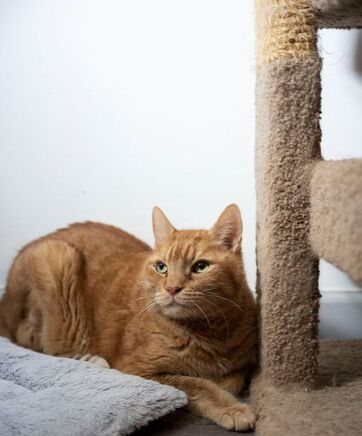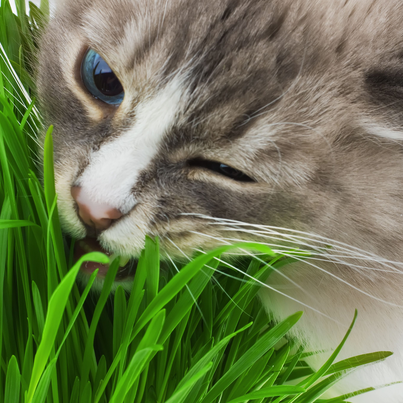Scratching and Chewing
Left unchecked, indoor cats can cause significant household destruction. Some cats chew on houseplants and eat strange materials like dirt, leather, and wool – a condition known as pica. Others use furniture as scratching posts and turn curtains into a playground. Your cat’s destructive behavior can be managed by offering your cat more appealing options as well as making former choices less satisfying.
Scratching is a normal behavior for cats. They scratch to remove the dead outer layer of their claws, to mark their territory, to stretch their bodies and flex their feet and claws, to relieve stress, and to expend energy. Since scratching is a normal behavior, it is unrealistic to try to stop cats from scratching. Alternatively, resolving scratching problems should focus on redirecting the scratching onto appropriate objects.
Scratching is a normal behavior for cats. They scratch to remove the dead outer layer of their claws, to mark their territory, to stretch their bodies and flex their feet and claws, to relieve stress, and to expend energy. Since scratching is a normal behavior, it is unrealistic to try to stop cats from scratching. Alternatively, resolving scratching problems should focus on redirecting the scratching onto appropriate objects.

Problematic Scratching
Once your cat is consistently scratching the appropriate object, you can start to move it slowly to a more suitable location. Don’t move the object more than three inches each day, and it’s best to keep it as close to your cat’s preferred scratching locations as possible. Similarly, don’t remove the unappealing coverings or odors from the unacceptable objects until your cat is regularly scratching the acceptable objects for three to four weeks. When you do remove the coverings or odors, it should be done gradually.
- Nowhere for cat to scratch non-destructively. Provide your cat with scratching posts and show her how to use them to redirect her behavior.
- Solution: Provide objects for scratching that are appealing to your cat and convenient for them use. You can figure out whether your cat prefers scratching horizontally or vertically by observing the objects your cat is scratching. If your cat prefers vertical objects, provide her with a scratching post that has the following properties:
- Sturdy, with a wide base. It must be heavy enough to withstand a cat leaning and pulling on it
- at least three feet tall
- Is sisal covered or rope-wrapped
- Solution: Provide objects for scratching that are appealing to your cat and convenient for them use. You can figure out whether your cat prefers scratching horizontally or vertically by observing the objects your cat is scratching. If your cat prefers vertical objects, provide her with a scratching post that has the following properties:
Once your cat is consistently scratching the appropriate object, you can start to move it slowly to a more suitable location. Don’t move the object more than three inches each day, and it’s best to keep it as close to your cat’s preferred scratching locations as possible. Similarly, don’t remove the unappealing coverings or odors from the unacceptable objects until your cat is regularly scratching the acceptable objects for three to four weeks. When you do remove the coverings or odors, it should be done gradually.
- Object/furniture is desirable for cats
- Solution: Cats may like the feeling of materials such as cloth for scratching. These surfaces can be covered by double sided sticky tape, sandpaper or carpet runner to discourage inappropriate scratching. You can also use non-toxic sprays that contain ingredients cats dislike.
- Nails are too long
- Solution: Regularly trim the cat’s nails and buy plastic caps (Soft Paws) to be put on the nails.
- Anxiety
- Solution: Try calming additives like plug-in diffusers or sprays that simulate a cat’s natural pheromones. Brands that are sold in pet stores and on Amazon include Feliway, Comfort Zone, Thunderease, and Well & Good.
- Solution: Try calming additives like plug-in diffusers or sprays that simulate a cat’s natural pheromones. Brands that are sold in pet stores and on Amazon include Feliway, Comfort Zone, Thunderease, and Well & Good.
Punishment?
Punishing your cat for scratching is only effective when it’s done while your cat is in the act of scratching the inappropriate object and you have provided her with an alternative, acceptable scratching object. Punishment after the fact won’t alter her behavior and may negatively affect your relationship. If you do catch her scratching unacceptable objects, using a remote form of punishment is best. Some examples of remote punishment are making loud noises or squirting her with water.
Punishing your cat for scratching is only effective when it’s done while your cat is in the act of scratching the inappropriate object and you have provided her with an alternative, acceptable scratching object. Punishment after the fact won’t alter her behavior and may negatively affect your relationship. If you do catch her scratching unacceptable objects, using a remote form of punishment is best. Some examples of remote punishment are making loud noises or squirting her with water.

Managing Pica
When dealing with pica, the first step is to have your vet rule out any medical issues, such as metabolic imbalance. Once your cat has been given the all clear, try some of the following suggestions to protect your plants:
When dealing with cats who eat or chew non-plant items, try to keep these objects in drawers, closets, or closed containers. Chewing inappropriate objects may be a signal of boredom and isolation, so be sure to provide your cat with plenty of her own toys to keep her distracted. Try to increase the amount of exercise she is receiving and rotate her toys every few days to keep her interested.
References
“Household Destruction.” Petfinder, www.petfinder.com/cats/cat-problems/cat-household-destruction/.
“PAWS - People Helping Animals.” Destructive Scratching - Prevention and Solutions » PAWS, www.paws.org/library/cats/behavior/destructive-scratching/.
When dealing with pica, the first step is to have your vet rule out any medical issues, such as metabolic imbalance. Once your cat has been given the all clear, try some of the following suggestions to protect your plants:
- Hang tabletop plants or put them in an off-limits room
- Spray leaves with an anti-chew spray for plants and put double-stick tape on the planters. Cats will avoid surfaces that are sticky to the touch.
- Provide your cat with flats of catnip and wheatgrass to satisfy her craving for fresh vegetation.
When dealing with cats who eat or chew non-plant items, try to keep these objects in drawers, closets, or closed containers. Chewing inappropriate objects may be a signal of boredom and isolation, so be sure to provide your cat with plenty of her own toys to keep her distracted. Try to increase the amount of exercise she is receiving and rotate her toys every few days to keep her interested.
References
“Household Destruction.” Petfinder, www.petfinder.com/cats/cat-problems/cat-household-destruction/.
“PAWS - People Helping Animals.” Destructive Scratching - Prevention and Solutions » PAWS, www.paws.org/library/cats/behavior/destructive-scratching/.